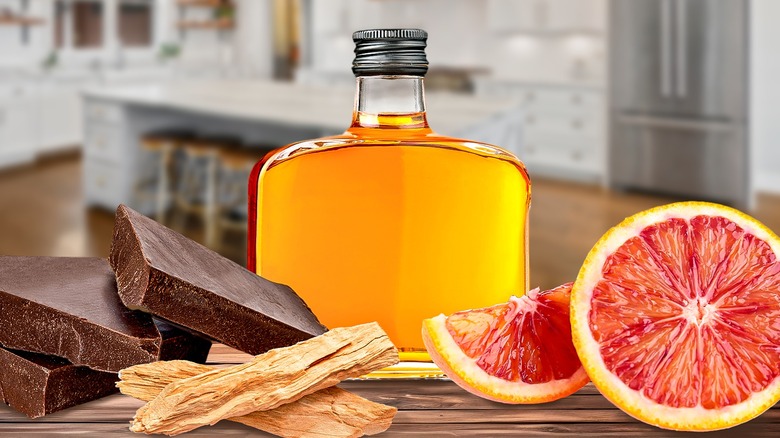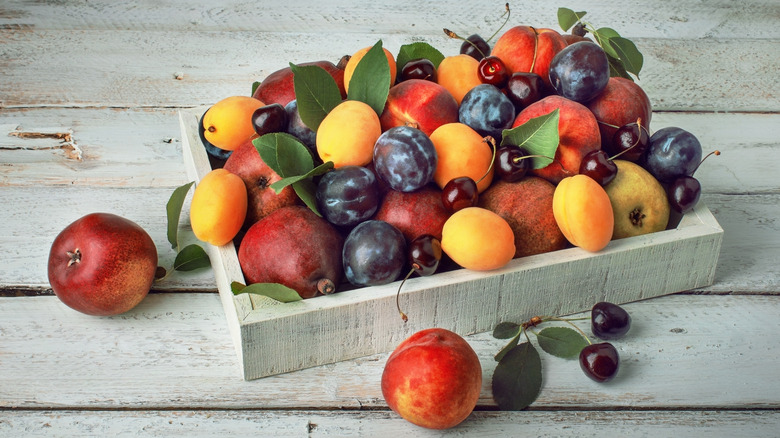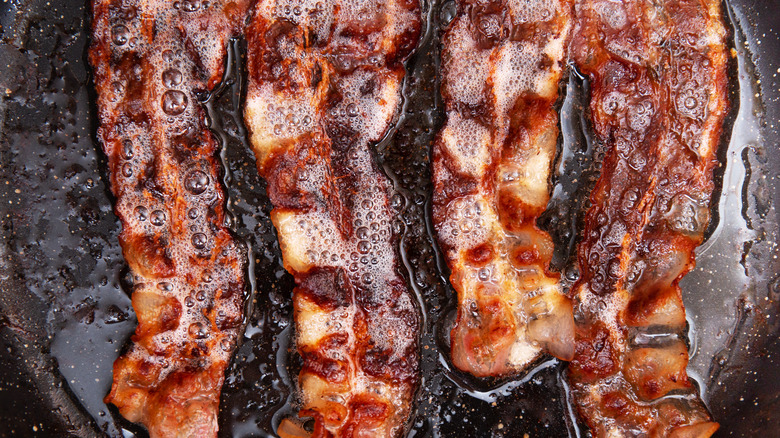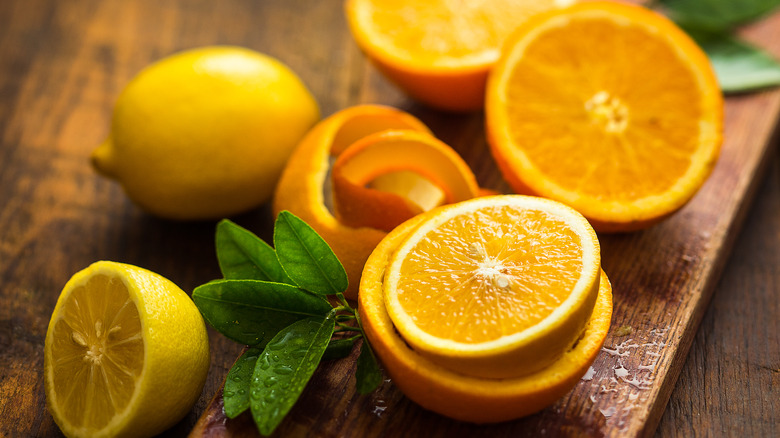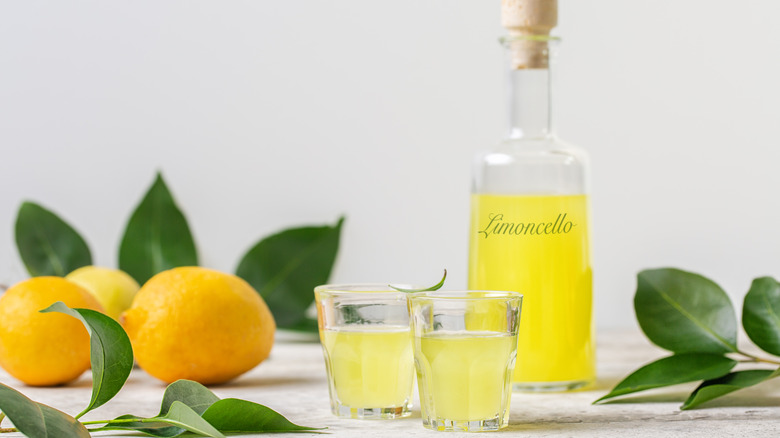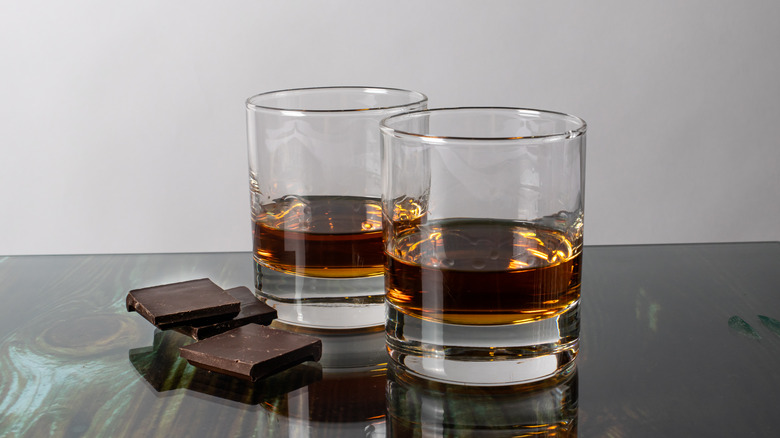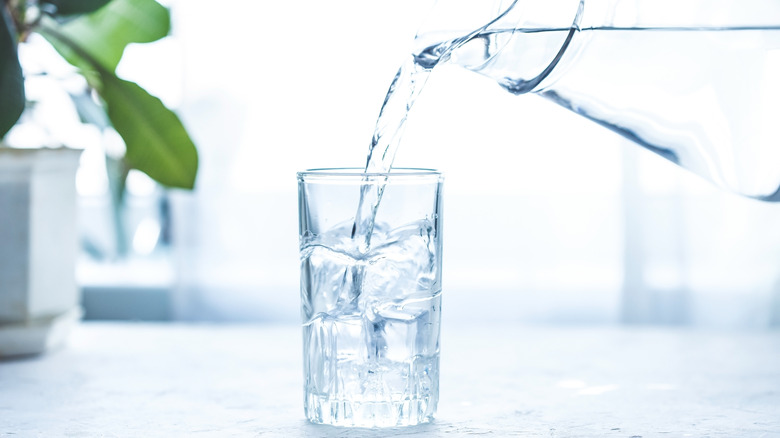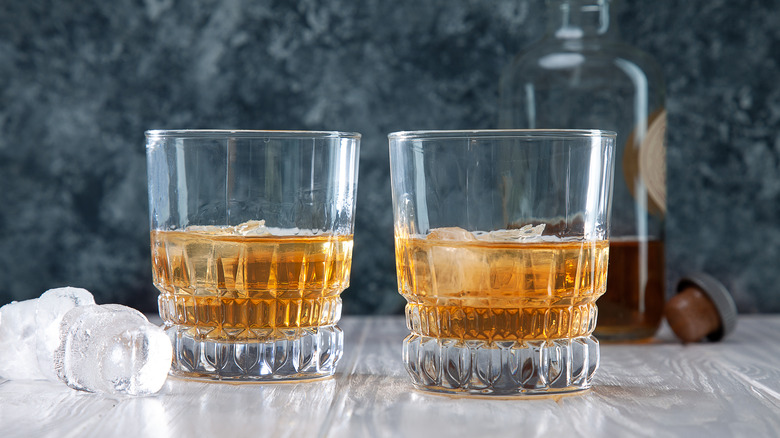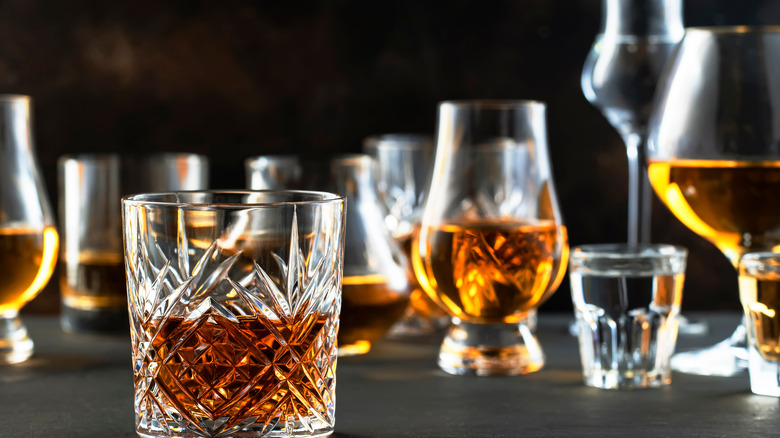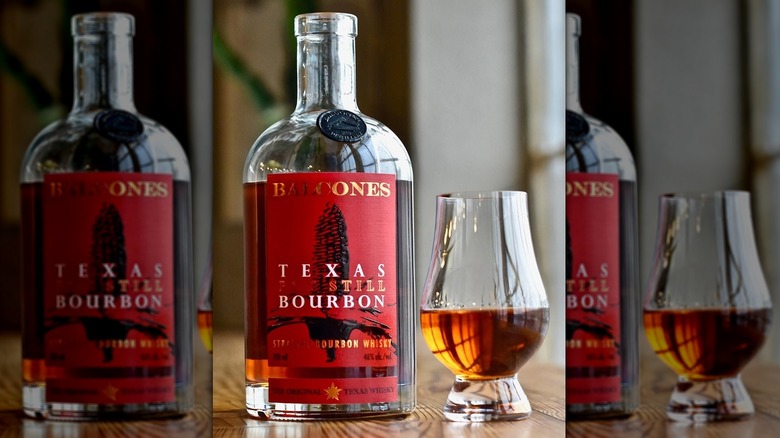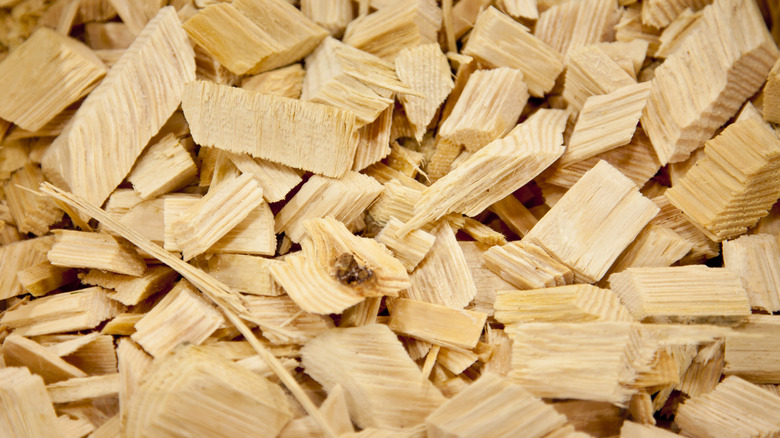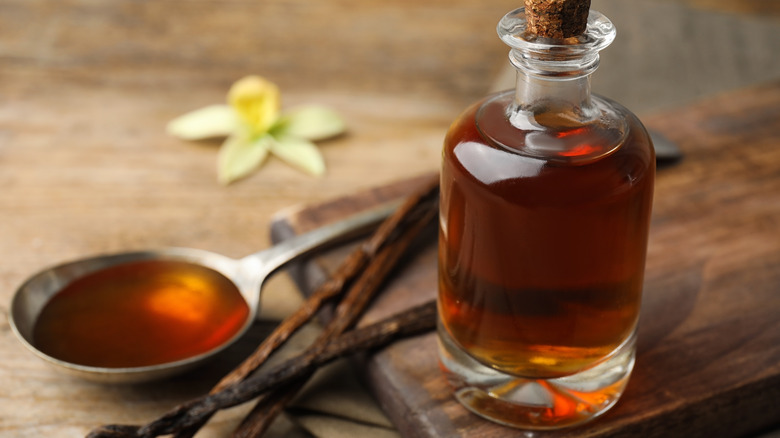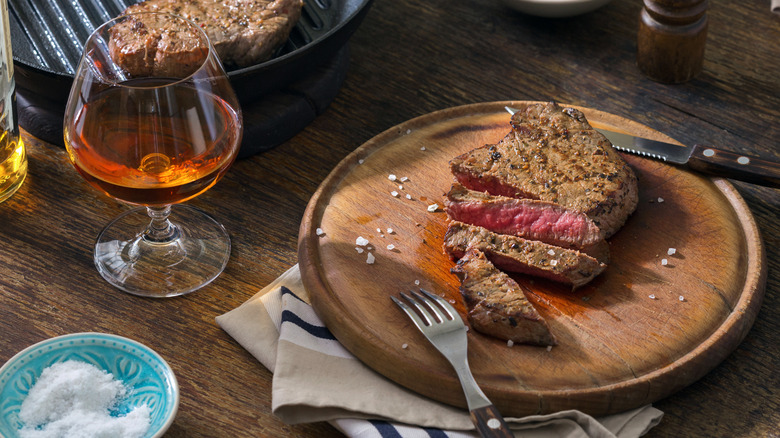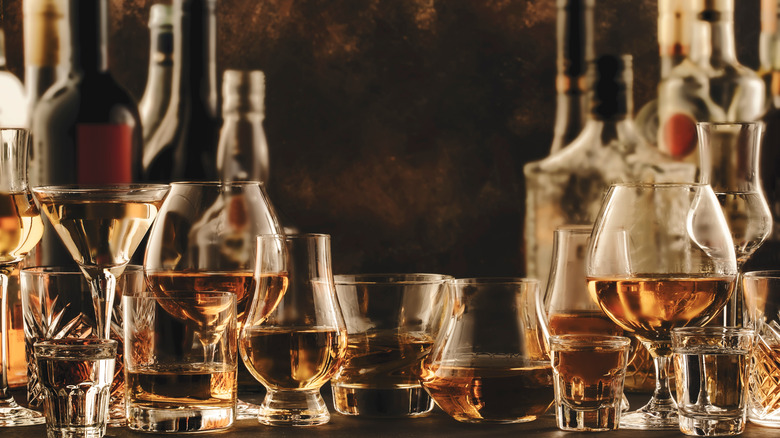13 Ways To Upgrade Bourbon Right At Home
Sipping a bourbon at the end of the day is an easy reward to look forward to. And we all desire to enjoy the highest quality option available. However, high-quality, well-aged bourbon will likely have a higher price, which is unattainable for many. Still, there are creative ways to make an inexpensive whiskey taste like fine-aged bourbon by enhancing the taste, often using products already in your fridge or pantry. We've compiled a list of clever ways to upgrade bourbon at home, adding a twist to the standard flavor profile.
As a former bartender and longtime bourbon enthusiast, I have dabbled in various techniques to transform its taste and character. Adding to my experience, we researched suggestions from other whiskey aficionados, gathering tips and recommendations. Depending on your preferences, these liquor upgrades can occur quickly or over time. Some suggestions included in this list are more straightforward than others, requiring minimal effort. However, we promise each option will boost the flavor of your typical bottles of bourbon and, in turn, elevate the taste of classic cocktails.
Add aromatic bitters
Adding aromatic cocktail bitters is a quick option for transforming the flavor of bourbon. If you are a cocktail enthusiast, you likely have a bottle in your liquor cabinet now. Brands like Angostura and Peychaud have been a part of a bartender's toolkit since the mid-19th Century. Aromatic bitters are botanical-infused liquids with a powerful aroma and sharp, bitter, acidic taste. Bitters were initially used for medicinal reasons, as herbs, bark, and plants were common natural remedies in the early 1800s.
The creation of aromatic bitters occurs by steeping ingredients like clove, cinnamon, orange peel, and peppermint in a high-alcohol-neutral spirit for an extended period. As the botanicals steep, the liquor will cause the flavors to extract into the spirit, creating the bitters.
Adding bitters to your glass of bourbon will deepen the flavor, strengthening the liquor's natural toffee, dried orange peel, and spice notes. The flavor of the bitters is potent, so a dash or two is plenty to enhance the bourbon's flavor greatly. Though the base is at least 95% alcohol, there is no need to worry about how much alcohol is actually in bitters as you are only using a few drops.
Infuse with orchard or stone fruit
Adding stone or orchard fruit to bourbon will strengthen the liquor's natural sweetness while enhancing the fruity flavors. Infusing will also help smooth the palate, mellowing the alcoholic bite. Of course, buying flavored bourbon is an option; however, infusing bourbon yourself will ensure that only all-natural ingredients will go into the liquor instead of artificial colors or flavorings. You will also be able to adjust the intensity of the fruit's flavor depending on how long you allow the fruit to steep.
For infusing bourbon with fruits, options that pack a strong flavor are best. Select options like tart Granny Smith apples, high-sugar cherries, or ripe golden peaches. We also recommend using bourbon that is under 100 proof. Higher alcohol products, like those over 50 alcohol by volume (ABV), can infuse faster but also have a chance to become bitter. Over-extracting the fruit will also cause the spirit to taste bitter. Going slow will ensure the resulting spirit is smooth and full-flavored.
To infuse the bourbon, pack your thickly sliced fruit and the spirit in sealable containers, like a mason jar, and place on a cool, dark, dry shelf to infuse for 24-48 hours or up to a few weeks. When the taste is to your liking, strain the bourbon, saving the fruit for desserts like a boozy bourbon apple pie. Use the bourbon to create imaginative cocktails at home, like trying apple whiskey mixed with bubbly wine for a sweet, earthy, refreshing aperitif.
Fat-wash the whiskey
Just the thought of bacon bourbon makes our mouths water. Smokey, meaty bacon with toasty, nutty whiskey combine harmoniously. However, we aren't suggesting adding a crispy slice to your next lowball. Instead, add a spoonful of bacon fat to the bourbon. The technique is known as fat-washing. Though it takes time, the fat-washing process is straightforward. It results in a bourbon with a mouth-watering smokey bacon flavor and a silky texture, imparting a creaminess on the palate.
Beverage Director Don Lee debuted the enhancement in 2007 at New York City's Please Don't Tell (PDT), infusing bourbon with hickory-smoked bacon fat. However, any fat will work, including pecan butter, enhancing the nuttiness of the bourbon, brown butter, bringing out the earthy richness, or even roasted bone marrow, adding meaty complexity.
To fat-wash bourbon, begin by heating the fat of choice until liquified, then pour it into a sealable container. Add the whiskey and let sit for two to four hours, shaking the jar occasionally to move the fat around. If using bacon fat or nut butter, an ounce or two is plenty for a 750-milliliter bottle. Remove the lid and place in the freezer until the fat has solidified. Skim the fat off and strain through a fine mesh sieve lined with cheesecloth or a coffee filter.
Use the liquor to update classic cocktails, transforming the flavor of an Old Fashioned or Classic Manhattan. Or, add a few splashes to homemade bacon jam, enhancing the savory flavor.
Add citrus
Adding citrus, like orange, tangerine, or lemon, to bourbon is a quick way to elevate the refreshing characteristics found in bourbon. Like adding citrus to chicken or fish, the fruit's acidity will lift the palate, cutting through the barrel-aged whiskey's richness while enhancing the bourbon's fruit flavors, like orange peel, dried apricot, and nectarine.
The combination of adding citrus to liquor dates back to the 1600s when sailors from the British Royal Navy combined Caribbean rum with lime juice, creating the sour cocktail's precursor, Grog. The combination worked double duty as the citrus helped combat scurvy while the liquor made long nights at sea tolerable.
There are several ways you can combine whiskey and citrus. The first is adding a fresh lemon or orange twist to bourbon served neat. Twisting the citrus peel into the spirit will release the fruit's natural oils and aromas into the drink, adding depth and nuance.
Or, create a classic sour cocktail by combining three parts bourbon, two parts fresh lemon juice, and one part simple syrup. Following these ratios will produce a perfectly balanced whiskey sour. Bourbon is the best alcohol for the classic cocktail as the liquor's mash bill of at least 51% corn makes it naturally sweeter and smoother than other options, like rye or scotch. If you feel even more adventurous, muddle lemon wedges in a glass. Add bourbon, simple syrup, and mint with ice, creating a refreshing, herbaceous whiskey smash.
Mix with limoncello
It may sound wild, but we suggest mixing limoncello with bourbon for a refreshing summer drink. Similar to how citrus enhances the taste of bourbon, limoncello gives the whiskey a refreshing flavor boost, cutting through the brown liquor's earthy, toasty, nutty notes. Limoncello is an Italian liqueur from areas around the Amalfi Coast, Sorrento, and Capri using the peels of Femminello St. Teresa lemons or Sfusato Amalfitano lemons, both with high oil content in its skins to create the drink Italians call sunshine in a bottle.
The Italian liqueur also includes a high level of sweetness as the ingredients include lemon zest, alcohol, sugar, and water. Lemon zests macerate with alcohol for around 80 days. After 40 days, a high-sugar simple syrup goes into the mix, resulting in an intensely sweet, highly aromatic drink with a tangy, lemony flavor. Combining bourbon and limoncello with ginger beer creates a citrusy twist to a spicy Kentucky Mule. Or, create a Fools Gold cocktail combining bourbon, limoncello, and lemon juice.
Infuse with chocolate
Whiskey and chocolate are an ideal match. Sweeter whiskey, like bourbon, has nutty, caramel, and vanilla notes that will meld with the candy's milky, chocolatey flavors. While you can enjoy the combination by sipping a dram while eating chocolate treats, we suggest infusing the liquor instead. Infusing bourbon with chocolate adds flavor while softening the finish. Understand that not just any type of chocolate will work, and please don't mix chocolate chips or syrup into your bottle of bourbon. Both add unnecessary ingredients, including fat and sugar. Instead, cocoa nibs work best.
Cocoa nibs come from the core of the cacao bean pod. While they provide a taste similar to a Hersey bar, it is much more intense with multi-dimensional layers of fruity, earthy, roasted flavor and a bitter chocolate bite. Adding them to bourbon mellows the natural sweetness, highlighting the toasty, nutty, smoky flavors while enhancing the fruit notes.
The infusion process is similar to that for fruit. Add one-quarter cup of cocoa nibs to a sealable jar, top with bourbon, and seal. Place on a cool, dark shelf for 48 hours. After two days, taste the liquor to see if the bourbon has a pronounced chocolate flavor to your liking. If it is not, continue the infusion, tasting every day until the liquor has achieved a rich chocolate flavor. If so, strain and use in your favorite classic or chocolate cocktails. We find it transforms a mint julep into a chocolatey, minty delight.
Add water
For those who prefer a simple drink without much shaking or mixing but find the taste of bourbon too strong to be sipped neat, we suggest you dilute whiskey with water. While some brown spirits enthusiasts believe enjoying a dram neat is the only way to drink whiskey, others believe adding water can enhance the flavor and soften the alcoholic bite.
Water is essential to bourbon production, lowering the alcohol levels before bottling and ensuring the distillery's product has the preferred taste and aroma. Similar to how water affects whiskey during production, adding a splash of water to your nightly two or three-finger pour will change the chemical makeup of the whiskey, rearranging molecules and helping aromas and flavors that are otherwise undetectable rise to the surface.
The amount needed to find the previously hidden characteristics without watering down the whiskey is a personal preference. We find it is likely around two teaspoons. Still, we recommend conducting your own taste test. Pour a dram and sample as you add a splash of water to the glass. As you taste, you will notice the aromas and flavors change, along with the texture of the spirit in your mouth. The type of water you use can also alter the bourbon's character, so it is best to use water of high quality.
Change the temperature
There is a similar debate to adding water to whiskey on whether to chill or add ice to the liquor. Some bourbon fans believe a chilled bourbon will have a more refreshing flavor. Others suggest you shouldn't store your bourbon in the fridge and consider it an outrage to serve it over ice. There is reason to agree with either side.
Proponents of sipping chilled bourbon believe the cooler temperature smooths out the whiskey's harsh alcoholic notes, providing a more enjoyable drinking experience. Using large spheres or cubes of ice will chill the bourbon while melting slowly so that the liquor does not dilute as quickly as using something like water or smaller ice cubes. The reverse argument is that chilling bourbon will cover the subtle nuances of bourbon, masking refined aromas and flavors. While this may be a plus in lower-quality selections, it is generally not ideal. The sensory characteristics are part of why we drink whiskey.
Those who oppose chilling may also believe the only way to drink bourbon is neat and always at room temperature. They might prefer to warm the whiskey instead, cupping the glass in their hands to help further release the bourbon's aromas. We suggest trying bourbon both ways to decide which style, cool or warm, you prefer.
Use quality glassware
One of the easiest ways to upgrade the taste of your favorite bottle is to ensure you are using the correct type of glass. The type of glass you use when drinking bourbon can affect the flavors and aromas of the whiskey, so utilizing quality glassware will ensure complete drinking pleasure.
One of the best glasses for sipping bourbon neat is the Glencairn, a tulip-shaped glass with a wide bowl that narrows at the rim. The bowl allows air to circulate in the bottom while pushing the aromas toward the top. A snifter or brandy glass will work similarly; however, the size is more substantial, making it easy to over-pour your cocktail. A lowball or rocks glass is also a good choice for sipping with a splash of water or ice or in a cocktail, allowing the ingredients plenty of room.
The glassware material is also essential. Plastic cups can alter the taste of the whiskey. Instead, go with an option made of glass or crystal. The glassware doesn't have to be expensive. Still, making a small investment in a well-made product will go a long way to heighten your enjoyment.
Allow it to breathe
Aerating whiskey by allowing the alcohol to mix with oxygen will help release aromas while removing the alcoholic bite, particularly with high alcohol and highly complex bourbon. Using this upgrade with a young bourbon that is less complex may cause the flavors to taste flat or completely disappear. Instead, we suggest trying this method with a quality, bottled-in-bond bourbon that adheres to strict production standards, including the bourbon must be bottled at 100-proof and aged a minimum of four years in charred new oak barrels. Bourbon crafted with these regulations is known for being of high quality, offering complexity and character.
The amount of time you should allow the whiskey to breathe is of a personal taste. The process is simple, though. Pour a double shot of bourbon into a glass with a wide bowl and let it sit for a few minutes to allow the alcohol to evaporate. Swirl the glass gently to allow the bourbon to come in contact with oxygen in the air, then taste. The flavors and aromas should heighten by slightly oxidizing the whiskey, becoming more pronounced and creating a more enjoyable drinking experience.
Infuse with wood chips or sticks
Bourbon's aging rule requires at least two years in new, charred oak barrels. Though production requirements are consistent across the board, not all bourbon whiskey's are alike. More extended oak aging deepens the sweet spice, dried fruit, and toasty oak flavors the barrel gives the spirit while creating a smooth, soft, velvety texture. Though the extended aging creates a delicious flavor profile, these bourbons are often higher priced than others.
There are ways to elevate an inexpensive bourbon, mimicking the flavors extensive aging gives, by infusing the spirit with cured wood sticks or chips. Allowing toasted wood chips to macerate with bourbon for some time will impart smoky, vanilla, and caramel notes into the spirit. Using chips from cherry, peach, or apple trees will enhance the liquor's fruity flavor.
The infusion should be complete within 48 hours instead of the several years it takes in the expensive stuff. After the whiskey has achieved a taste that is desirable to your preference, use the bourbon-soaked wood chips to transform the flavor of your next barbecue, adding sweet whiskey flavor to a low and slow brisket or pork shoulder.
Enhance with sherry, vanilla, and smoke
To enhance the flavors the barrel gives to the bourbon without waiting for an infusion to complete, you can recreate the flavors the wood chips give with a few liquid alternatives. Adding small amounts of dry amontillado sherry, vanilla extract, and liquid smoke will mimic the flavors that a barrel gives to bourbon, enhancing an inexpensive option's flavor.
Restraint is crucial when utilizing this upgrade. Each ingredient is potent, delivering undesirable effects if you add a high amount of flavoring, which will overwhelm the overall taste of the liquor. Practice restraint instead. We suggest beginning with an inexpensive 750-milliliter bottle of bourbon. To that, add one tablespoon of oxidized amontillado, strengthening the dried fruit and nutty caramel notes, a few drops of vanilla extract to enhance the creamy sweetness, and a scant amount of liquid smoke, mimicking the flavor the charred American oak barrels give to the aged liquor.
The combination provides the perception of a higher quality product on the palate. However, it likely won't change the texture or mellow the alcohol's astringency.
Pair with food
The easiest way to upgrade the flavor of bourbon is by enjoying a glass over dinner, with food items that will enhance the whiskey's natural flavors. There are guidelines to pair food with bourbon in the best way possible. First, check the proof of the bourbon. A whiskey with higher alcohol will appear harsher on the palate, making it challenging to find the nuances and subtlety of the aromas and flavors. These bourbons are better with more robust dishes, like fatty ribeye steaks, roasted lamb, or other game meat. Lower-proof bourbon will meld better with lighter dishes like fish or seafood.
It is also essential to check the age of the bourbon when pairing. Younger selections are not as complex and have not taken on the deep characteristics that longer aging provides, making them better with lighter fare, like vegetarian dishes, grilled chicken, or cheese dishes. Bourbons over nine or ten years old, showing the oak's toasty, spicy, nutty notes, work better with rich beef and game options, highlighting the complexity and richness.
Methodology
To create our list of upgrades, I relied on my experience as a trained sommelier and whiskey enthusiast who loves entertaining. Every dinner party has a signature cocktail, often using liquors flavored from my at-home infusions. For upgrades I have yet to try, I turned to reliable whiskey fans, researching tips and tricks online to ensure you get the most out of your bottle of bourbon.
Static Media owns Tasting Table and Mashed.
